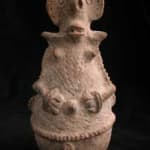Cham Terracotta Vessel, 19th Century CE - 20th Century CE
Terracotta
4.75 x 9.5
PF.5567 (LSO)
Further images
This enigmatic object was made by the Longuda or Cham/Mwana people of Northern to Eastern Nigeria. The piece is ostensibly a vessel but had a super-secular function. It is essentially...
This enigmatic object was made by the Longuda or Cham/Mwana people of Northern to Eastern Nigeria. The piece is ostensibly a vessel but had a super-secular function. It is essentially a dome-based receptacle with an extraordinarily complex anthropomorphic superstructure. The trunk narrows from the hatched band around the “waist” towards the shoulders, and is comprised of dashed clay rather than the bare clay of the base section. The face is mounted on the neck of the vessel and is decidedly demonic, with large protruding flanges that would seem to be ears if the vertical-oval eyes weren’t incised partly onto them, a round snout and a protruding coffee-bean mouth. The thin, hatched arms rest bracelet-heavy hands on the abdomen, beside the protruding umbilicus. The figure also has two spikes protruding from the neck, and a small eminence (genitalia) beneath the hatched waistband. Each hip and shoulder is decorated with what appear to be hatched clay wings of different sizes, and a hatched clay band around the neck. The coiffure is a triple hatched clay band, which opens onto the orifice at the top of the piece. The small piercings around the perimeter of the face/ears suggest that they once held fibrous tags or threads, presumably as adornment although a magico-religious reason cannot be ruled out.
These groups are defined primarily on their use of the Adamawa language group, which is spoken across Nigeria, Cameroon and Chad. Like the language itself, comparatively little is known of their ways of life. They are sedentary agriculturists with highly variable social characteristics, mainly because the lines that divide the groups are not clearly defined and many are more closely aligned than others. According to the sparse ethnographic data the current piece was an ininate (Cham) or kwandalowa (Longuda), a pseudovessel that was endowed with magical powers. They may have held liquids, but their main role was as a conduit for positive spiritual influence during healing, acting as a protector and also for soothsaying when in the hands of a suitably appointed personage. They are usually anthropomorphic or zoomorphic, or aspects of both, and some features are clearly imagined or linked to the mythology or oral history of these peoples. Styles were very variable – the practice seems to have become extinct in about the 1950s – and there is presumably an artistic geography of ceramic styles. Some variants are very phallic, perhaps implying some sort of fertility function.
This is a well-made and finished piece of African magical paraphernalia, and a worthy addition to any collection of Africana.
These groups are defined primarily on their use of the Adamawa language group, which is spoken across Nigeria, Cameroon and Chad. Like the language itself, comparatively little is known of their ways of life. They are sedentary agriculturists with highly variable social characteristics, mainly because the lines that divide the groups are not clearly defined and many are more closely aligned than others. According to the sparse ethnographic data the current piece was an ininate (Cham) or kwandalowa (Longuda), a pseudovessel that was endowed with magical powers. They may have held liquids, but their main role was as a conduit for positive spiritual influence during healing, acting as a protector and also for soothsaying when in the hands of a suitably appointed personage. They are usually anthropomorphic or zoomorphic, or aspects of both, and some features are clearly imagined or linked to the mythology or oral history of these peoples. Styles were very variable – the practice seems to have become extinct in about the 1950s – and there is presumably an artistic geography of ceramic styles. Some variants are very phallic, perhaps implying some sort of fertility function.
This is a well-made and finished piece of African magical paraphernalia, and a worthy addition to any collection of Africana.







